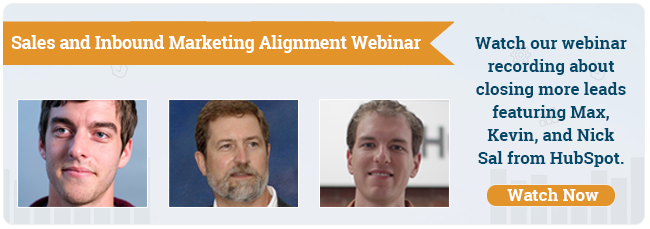 Have you ever visited a car dealership just to see what was available and, the second you set foot on the lot, were ambushed by a salesperson?
Have you ever visited a car dealership just to see what was available and, the second you set foot on the lot, were ambushed by a salesperson?
Have you ever been searching for information on a website only to have it obscured within five seconds by an “online help” avatar offering “assistance” (which you know is really just a chat with a pushy sales rep)?
It’s annoying, right? It’s annoying because that car salesperson and that website don’t respect where you are in the buyer’s journey—looking for information about a problem you’re trying to solve but not nearly ready to buy anything. We call this the awareness stage – you know you have an unresolved need and you are simply trying to educate yourself about possible solutions.
If the members of your organization’s sales team are complaining about the quality of leads generated by your inbound marketing efforts, it’s probably because they are trying to sell to awareness stage leads, leads that aren’t ready to buy.
This happens either because your inbound marketing process isn’t qualifying prospects beyond the awareness stage (you’re passing unqualified leads to sales) or because sales is jumping the gun (like the car salesman or the website avatar) and trying to sell to a prospect that isn’t ready to buy. The vast majority of sales’ frustration with online lead generation originates from a sales engagement with an awareness stage lead.
For inbound marketing to work, your sales team needs to understand where each lead is along the buyer’s journey and the most effective way to approach leads at each stage. As an inbound marketer you must work with sales to define the buyer’s journey for your company.
We call this sales and marketing alignment. We say a business’s sales and marketing teams are aligned when they are on the same page with how to identify and approach the different stages of leads.

© Content Marketer’s Blueprint 2014
Automated marketing technology helps marketers identify where a lead is in the buyer’s journey. All the leads we gather can be segmented into three distinct stages of the buyer’s journey—awareness, consideration, decision—each with its own set of characteristics. Better alignment between marketing and sales can accelerate conversion of qualified leads and enable more effective filtering of unqualified leads at each stage in the process.
In this series of three articles, we’ll be talking about how to prepare your sales team to interact with leads at each of these three stages, starting with the awareness stage.
Personal development guru Stephen Covey taught that any process is more effective if it begins with the end in mind. If the goal is more, better-qualified sales leads, how can we engage awareness stage leads to achieve that goal?
Awareness Stage Leads
The awareness stage is the first stage of the buyer’s journey, when a lead has just been confronted by a problem they need to solve. Buyers in this stage try to understand their problems and educate themselves on potential solutions using online research; this is how they found your website and your top-of-the-funnel (informational) content.
You can identify awareness stage leads because they download educational content that is not related to your specific brand or solution, but instead identifies the problem they are trying to solve and teaches them about possible solutions.
For example, one of our client’s business is providing hypnotherapy education to therapists. If one of their leads downloads a white paper called “The Ultimate Guide to Clinical Hypnotherapy Techniques,” it tells us they are an awareness stage lead; they are interested in learning more about hypnotherapy and how it can benefit their practice, but not ready to invest in a training program.
If that lead goes on to download a PDF that talks about setting up a call with a hypnotherapy educator, it means they have moved past the awareness stage. They’ve identified a specific solution that can help them solve their problem.
Set Expectations
Here is the most important thing marketing can communicate to sales: Awareness stage leads are not ready to buy!
If you don’t set sales’ expectations correctly and a salesperson spends time trying to sell people that are not ready to buy, they will get frustrated quickly and accuse marketing of generating poor quality leads. Then, when you finally do send over well-qualified leads, sales won’t pay attention to them.
Does this mean sales should never reach out to awareness stage leads? Not necessarily. Sales can still play a valuable role at this point in the buyer’s journey, gathering important information and nurturing awareness stage leads, but they need to tread lightly and have the correct expectation of the buyer-salesperson relationship.
In some businesses that are highly consultative, it’s perfectly reasonable for a salesperson to engage at the awareness stage and facilitate the education process… again, so long as marketing and sales are aligned and each understands their role in the buyer’s journey. If sales does decide that they need to reach out to awareness stage leads, their number-one goal should be to be helpful.
When dealing with awareness stage leads, instruct your sales team to introduce themselves as a helpful resource. They’re not there to sell anything. If the prospect has a minute to talk about their problem, perhaps your sales team can help by passing along some relevant information.
Pass Along Specific Information
One of the most valuable things about marketing automation tools is that they give you a goldmine of information about every lead at your fingertips. You can tell what each lead is interested in, either because of the content they downloaded or because of a question you asked them in an online form.
This is exactly the kind of information that will help sales reach out to an awareness stage lead in context and be as helpful as possible. It gives them a logical reason for reaching out: “I saw that you downloaded our whitepaper on social media ROI. I wanted to make sure you got everything you were looking for.”
Armed with this information, sales can prepare for the call and have additional relevant content at their fingertips: “Hey did you know that Facebook just limited the reach of posts to your audience to 1 percent, isn’t that crazy? That means you have to pay to get fans, then pay again to reach those fans.”
Notice there is still no overt selling going on. In this case, sales has the opportunity to build its reputation as a subject matter expert and establish trust.
Go The Extra Mile (and Sales Will Love You Forever)
If you want to put icing on the cake with sales, give them a map of all the content you have available on common problems that their prospects will face. This resource gives them quick and easy access to the white papers, webinars, and blog articles that may address specific questions that come up on a call.
Send your sales team a monthly update of the content map and use that as an excuse to check in with them and ask about how their follow-ups have been going with awareness-stage leads. A few good questions to ask sales would be:
- Are these leads really in the awareness stage?
- Are they actually interested in what we think they are interested in?
- What other questions do you get?
- Are there topics that come up that you need content for?
- What other information would be helpful for you to reach out to these leads?
Additional Resources for Email Follow-up
Giving sales an email script to work off of is a great way to foster alignment, so pass along these additional resources to get the ball rolling.


